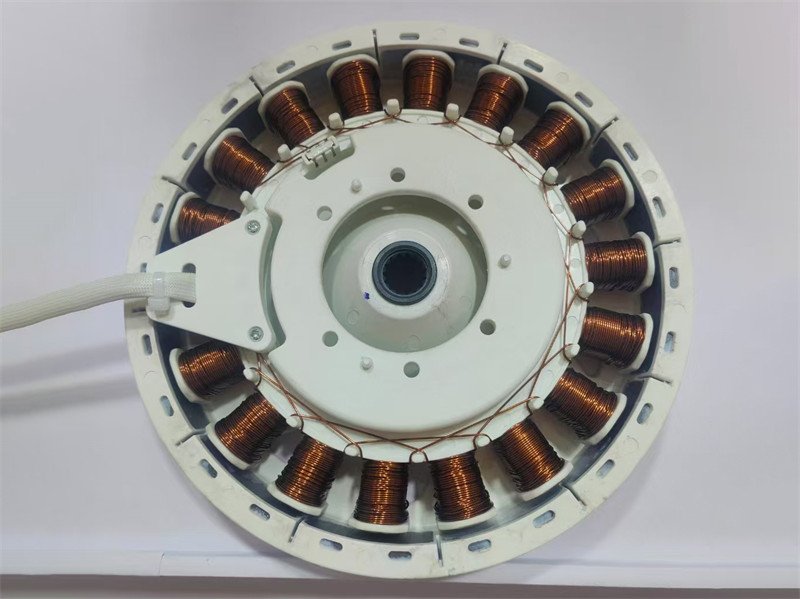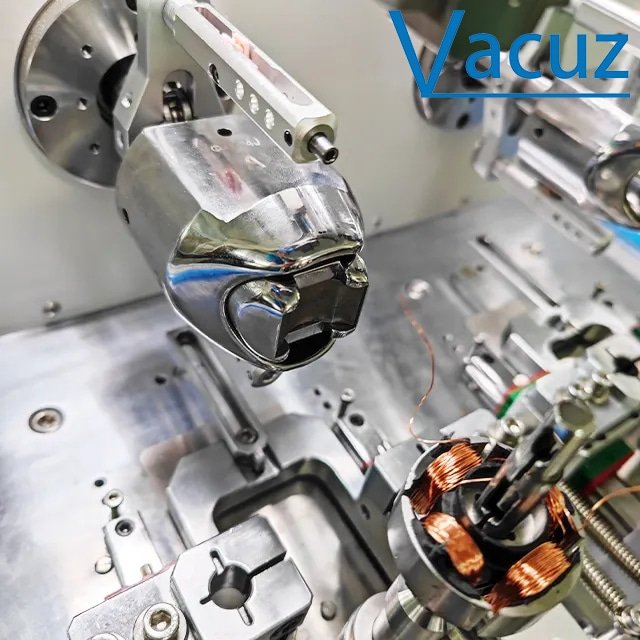Flying fork winding machines, also known as external winding machines and external rotor winding machines, are commonly used to wind stators for applications such as drone motors and fan motors. Their settings and parameters require precise control. So, how do you set the parameters for a flying fork stator winding machine? What are the advantages of using this winding method? Let’s take a brief look at these parameters with Vacuz!

1. Parameter Setting Method: Accurate Control for Efficient Production
Parameter setting for a flying fork stator winding machine requires comprehensive consideration of the stator structure, wire properties, and process requirements. Layered control is used to achieve precision in the winding process. The following describes the setup logic and optimization recommendations for key parameters:
1. Basic Parameter Configuration
1. Winding Speed:
For thin wire (≤0.1mm): The recommended speed is ≤500 rpm to avoid wire breakage at high speeds. For thick wire (≥0.3mm): The recommended speed is ≤300 rpm to balance efficiency and stability.
Dynamic Adjustment: The PLC monitors wire tension in real time and automatically reduces or pauses the speed to prevent wire breakage.
2. Tension Control:
The tension range for fine wires is 0.5-1.5N, and for thick wires is 2-5N. A dynamic compensation system (such as a hysteresis brake) is required to eliminate wire tension fluctuations.
Slot Crossing and Indexing:
The servo indexing system requires a preset flyer angle (such as 30° or 45°) to ensure the die head accurately engages the stator slot, with an error within ±0.1mm.
2. Multi-Station Collaborative Optimization
Independent Servo Drive: Each station can independently adjust winding speed and tension to prevent interference between stations.
PLC Scheduling: The master control system synchronizes parameters (such as speed and indexing angle) across all stations, supports parameter group storage, and allows for one-click recall during die changeovers.
3. Wire Route Design
Three-Dimensional Wire Route: The coil layer distribution is controlled by guard plate pressure (adjustable range: 5-20N) and die head stroke to prevent overlap and uneven spacing.
Mold Adaptation: Customized molds must match the stator slot depth/width ratio. For example, shallow-groove stators require reduced die pressure to prevent scratching of the enameled wire.
4. Non-standard Custom Parameters
Wire Diameter Expansion: By replacing the flyer nozzle (aperture 0.1-1.5mm) and the tensioner range, winding of ultra-fine wire (0.05mm) or flat wire is supported.
Improved Accuracy: A high-resolution encoder provides indexing angle feedback, achieving a repeatability accuracy of ±0.05mm.
II. Winding Advantages: Technological Innovation Drives Efficient Production
The flyer stator winding machine significantly improves production efficiency and product consistency through the following technological breakthroughs:
1. Efficiency Improvement
Multi-station Parallel Operation: The four-station design reduces the winding time for a single stator to 8 seconds, achieving a daily output of 2,000 units.
High-Speed Winding: The flyer speed reaches 2800 rpm with servo indexing, achieving a slot switching time of ≤ 0.1 second.
2. Precision Control
Dynamic Tension Compensation: Real-time adjustment of output force ensures a stable yield rate of over 99.5%, making it particularly suitable for high-voltage motor insulation requirements.
Three-Dimensional Wire Traversing Technology: The guard plate and die head work together to prevent coil crossover, reduce eddy current losses, and improve motor energy efficiency.
3. Flexible Adaptability
Quick Changeover: Modular fixture design (such as the quick-release flyer head) reduces changeover time to 5 minutes.
Wire Compatibility: Stable winding is possible, ranging from 0.1mm thin wire for model aircraft motors to 1.3mm thick wire for new energy motors.
4. Intelligent Integration
Automated Process: Integrated automatic wire trimming, clamping, and loading and unloading reduce manual intervention by over 60%.
Data Monitoring: The HMI interface displays winding parameters (such as tension curves and fault alarms) in real time, supporting production data traceability.

How do you set parameters for a flying fork stator winding machine? What are the advantages of winding? Vacuz has provided a brief explanation above. We hope this information is helpful!

